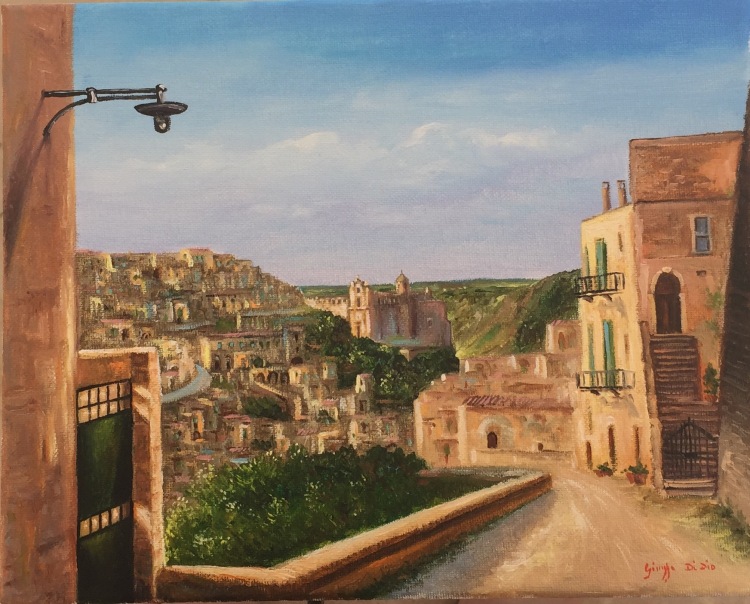Last September I visited the town of Matera in Basilicata, Southern Italy. I’ve written about Matera before – it’s polished stone path ways and rock-hewn houses. Most of all I was struck by the generosity and kindness of the people. In the far south of the Italian peninsula Basilicata is isolated from the rest of Italy. During the Fascist years Mussolini used the region as a dumping ground for anyone who didn’t agree with him – writers, politicians, intellectuals. The famous author and doctor Carlo Levi was exiled here[1]. In those days it wasn’t just the remoteness that could kill you, malaria had a good chance too. Levi wrote a memoir about his experiences where he describes eloquently the daily hardships of the people living in the region and the courage, resolution and determination they displayed.
Matera is perched on a rocky outcrop protected by a steep limestone gorge to the east. The town stretches along the hillside blending seamlessly into the rugged, arid landscape. For me Matera is quite beautiful, the cream coloured stone of the buildings almost sparkling in the sun. I’d just walked into a small square with a magnificent church, tourists were milling about. There was a traditional home, one of the sassi[2], where visitors could see how the locals lived until the 1960s. Now it is a tourist attraction.
A local lady was selling a small selection of paintings of the town. One of them caught my eye. A beautiful rendition of a path leading to the church and the valley beyond. The artist had captured the detail of the houses, staircases, gates, even the wrought iron street lamp in the foreground. The warmth of the stone radiated from the canvas. The painting invited the viewer into the town, to dream of the people who lived there once and how they spent their days. I decided to buy the painting, it had been € 40– but the lady had reduced the price to € 30– to make a sale. She told me that her husband does the paintings and she sells them.
When I got my money out to pay, the lady burst into tears and thanked me again and again for making the purchase. She then insisted that I pose for a photo with her to show to her husband. I smiled and showed off my painting. I shook the lady’s hand and went on my way. I’ve often thought about that encounter. I even discussed it with one of my tour guide friends from nearby. She explained to me, ‘You know life is really tough for people in this region. When we switched from Italian Lire to the Euro[3] it made life much more expensive, it gets harder and harder for people to make ends meet. When you bought that painting you gave that lady some money in her pocket. You demonstrated that you liked the painting and the work of her husband as an artist. You validated that woman’s existence in so many ways.’
Every time I look at the painting I think of the woman and the husband I never met. The painting is signed at the bottom and on the reverse. The artist is Giuseppe di Dio, that’s Joseph of God in English. I wonder if my guardian angel was trying to tell me something that day?
The painting in all it’s glory is reproduced below – for me it’s a treasured possession.
 Matera, Basilicata – UNESCO World Heritage Site
Matera, Basilicata – UNESCO World Heritage SiteNotes:
[1] Carlo Levi was exiled to Basilicata in the 1930s. He was opposed to the Fascist ideology of Mussolini. His novel ‘Cristo si è fermato a Eboli’ was published in 1945. The english translation ‘Christ stopped at Eboli’ is published in Penguin Modern Classics, translated by Frances Frenaye (ISBN: 9780141183213).
[2] The sassi are caves where local people lived, often in a one room dwelling that they shared with the family animals. These cave dwellings were inhabited until the early 1960s.
[3] The introduction of the Euro currency in 2002 conveniently masked a massive increase in the cost of living throughout Italy. Whilst Italians are masters of making ends meet and living and eating well, it has been a huge struggle for ordinary families ever since. At no time have politicians acknowledged this suffering. The problem extends throughout Italy, France, Spain, Portugal and Greece.
[4] The ‘Educated Traveller’ regularly runs tours in Southern Italy. The next tour runs from 14-26 April, 2019. A fabulous mosaic of experiences from Naples, Matera, Alberobello & Lecce, before continuing to Sicily, Ragusa Ibla, Taormina, Capo d’Orland & Palermo. Why not join us in 2019 to discover the ‘South & Sicily’. Click here – https://wp.me/p5eFNn-3Vh
For a short video on Matera click on UNESCO world heritage site (Matera)
It will be interesting to see how Matera celebrates this year as ‘European City of Culture 2019’
Written in 2019.
#Matera

And then last year is this the same lady who you bought another painting from when I was with you? I love this story, Janet!
LikeLiked by 1 person
Yes indeed it was Mary Lou Peter!
LikeLike
I think there is beauty and opportunity all around us – at all times – we just have to be careful that we don’t miss these magical moments!
LikeLike
This is beautiful, Janet–the painting and your story. We never know, do we, what effect we will have on another person?
LikeLiked by 1 person